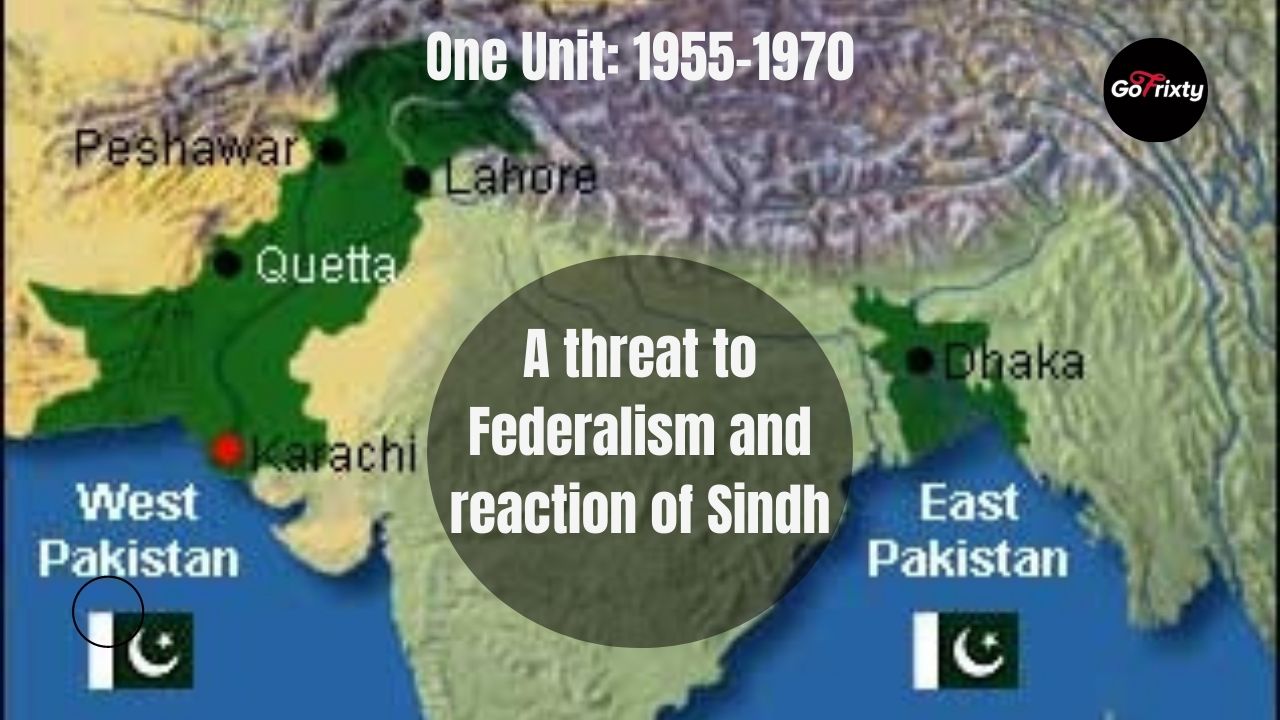Abstract
Pakistan has been a multiethnic state with varieties of languages, cultures and living styles since its inception. In this perplexing nature, federalism was only optioned to keep people united. But that too was not acceptable to the ruling oligarchy, for a true form of federalism would pave the way for Bengali supremacy owing to their large population which consisted 55% of the whole population. So, in order to suppress them (Bengalis), the scheme of One Unit was proposed. The story of One Unit is known as dark pages in the political history of Pakistan. It created hatred in the hearts of the people of smaller provinces of West Pakistan, for the central government claimed, it was formed in order to promote national unity within the country and to discourage provincialism. Moreover, it was also claimed that through this, the rights of people would be ensured and secured in a better way. But the central government failed to water their promises which were done. Consequently, the people of the smaller province started agitations against One Unit. This scheme was initiated in 1955 and lasted till 1970. These years are full of grievances for all three small provinces i.e. Sindh, NWFP (present-day KPK) and Balochistan. It might be considered as one of the reasons behind the fall of Dhaka because parity could not be followed on which One Unit was formed. In this regard, this paper attempts to unveil the interest of the central government behind the scheme of One Unit and it also concentrates on the role of Sindh in this scheme.
Keywords: Constituent Assembly, Sindh Assembly, Federation, West Pakistan, East Pakistan, Provincialism, Patriotism, Unification, One Unit
Introduction
After independence, Pakistan faced ethnic political problems throughout the country owing to ethnicity and geographical differences. Geographically, it was divided into two portions, about 1600 kilometres distant from each other. One portion was famous as East Wing (Bengali) and another one as West Wing (Punjab, Sindh, NWFP (Present-day KPK), Balochistan). When Muslim League was defeated in the provincial elections of East Pakistan in 1954 then West Wing politicians decided to bring all four provinces (Punjab, Sindh, NWFP, Balochistan) under one umbrella and unified all four provinces as a single province to encounter the East Pakistanis (Bengalis).
Thus, they launched ‘’One Unit Scheme’’, through the leadership of Prime Minister Muhammad Ali Bogra on 22 November 1954. Finally, on 5 October 1955, Acting Governor-General of Pakistan Iskandar Mirza passed an order for the unification of the Western Wing as a single province, known as West Pakistan and policy is called the ‘’One Unit Scheme’’. It is established that the suggestions to amalgamate West Pakistan into One Unit were made before 1954.
As early as November 1947, Sir Archibold Rowlands, M.A. Jinnah’s adviser on economic matters, recommended the unification of western wing, but although the Father of Pakistan approved the proposal in principle, he considered it premature and postponed the scheme. Punjabi interests representatives pleaded that the integration of the provinces into West Pakistan is the supreme national interest.
The idea of unification of the western wing put a new argument on the eradicating of ‘provincialism’, decreased the administration expenses and also powering the efficient administration. In the Constituent Assembly in March 1949, Malik Feroze Khan Noon made a plea for the merger of the four western provinces into a single unit in the interest of ‘efficient administration.
The merger proposal was also supported by Khan Muhammad Yusuf Khattak, General Secretary, Pakistan Muslim League, who remarked that the merger would not only eradicate the poisonous mentality of narrow provincialism but inculcate the undying spirit of unified Pakistani nationality. But the Muslim League President, Chaudhary Khaliquzzaman, was hesitant in supporting the proposal. He, therefore, emphasized that the willing consent of different provinces should be the sine qua non for any action in regard to the amalgamation of provinces of West Pakistan into a single unit.
Thus, the idea of unification of West Pakistan formed by Muslim League was not only a pre-requisite for the creation of the single unit but also as to overcome the increasing ethnicity of small provinces of West Pakistan.
Initiation of One Unit Plan
Pakistan came into being on 14 August 1947, and geographically into two portions separated by each other by thousands of kilometres. Thus, the Government had faced long difficulty in administrating East Pakistan with its border with Eastern India, and the four provinces of West Pakistan linked the border with Western India, Iran, China, and Afghanistan. Therefore, keeping in view the administrative difficulties in the idea of ‘One Unit System’ was conceived by Malik Ghulam Muhammad Governor General of Pakistan, whose drafting was completed by Prime Minister Mohammad Ali Bogra who had made the first official announcement on 22 November 1954. The National Assembly of Pakistan passed a bill merging all West Pakistan into a single province on 30 September 1955. Finally, it was implemented on 14 October 1955. Earlier in 1954, Prime Minister Mohammad Ali Bogra praised the idea and said, ‘‘There will be no Bengalis, no Punjabis, no Sindhis, no Pathan, no Balochis, no Bahawalpuris, no Khairpuris. The disappearance of these groups will strengthen the integrity of Pakistan’’.
Iskander Mirza (He held the office of President of Pakistan from 23rd March to 27th October 1958) had also forwarded the bill in the Assembly which had the following reasons:
It would end the curse of provincial prejudices.
It would allow the development of backward areas.
It would reduce administrative expenses.
It would make it easier to draw up a new constitution.
It would give East and West Pakistan maximum autonomy.
As a follow to the plan after the general election of 1954, the four provinces and Tribal areas were merged in the western wing. The region was composed of twelve divisions, and the provincial capital was established at Lahore and the capital of East Pakistan located at Dacca. The federal government moved the country’s capital in 1958 from Karachi to Rawalpindi while the national legislature moved to Dacca.
West Pakistan formed a single and united political entity but with marked linguistic and ethnic distinctions. The One Unit policy was regarded as an administrative reform that would reduce expenditure and help to eliminate racial prejudices. However, with the military coup of 1958, trouble loomed for the province when the office of Chief Minister was abolished, and the President claimed executive power over West Pakistan.
Dismissal of Pirzada’s Cabinet
The scheme of the ‘’One Unit’’ was enforced to Abdul Sattar Pirzada (He was a member of Pakistan Muslim League and was also CM of Sindh from May 22nd, 1953 to November 8th 1954) by the federal government, but he refused to do so. Thus, the meeting was called by the top-level for the approval of the scheme and dismissal of Pirzada’s Cabinet. The meeting was attended by Ayub Khuhro, Mumtaz Daultana, Qurban Ali Khan, Chaudhry Muhammad Ali and Sardar Rashid.
Pirzada was aware of his fate so he sought the support of Bengali and Pashtun allies and also got support from the members of the Sindh Legislative Assembly. Resultantly, 76 out of 110 members in a signed statement fully endorsed the Constituent Assembly and expressed full confidence in the Pirzada ministry. During the session of the Sindh Assembly on 15 November, he considered a resolution against the ‘’One Unit’’ and forwarded it to Governor. Before passing of it, there was a surprise for Pirzada that his ministry was dismissed immediately on the ground of maladministration of the affairs in the province. So, he reacted quickly and claimed that his removal was just because of rejection of the ‘’One Unit’’ not because of any other reason.
G.M. Syed was convinced that the dismissal of Pirzada cabinet was for no other reason except for his fair stand against the formation of One Unit. Sain GM Syed paid congratulation to Pirzada and his Cabinet for their boldness and he appreciated his steadfastness. On the other hand, Pirzada preferred to be dismissed rather than surrender himself and his cabinet. Imam Bakhsh Talpur, a former minister of Sindh also congratulated Pirzada on his gallant stand over One Unit.
On the other hand, Bahawalpur state also rejected the scheme of unification of western wing into a single unit. But Sardar Abdul Rashid, Chief Minister of North-West Frontier Province and Khairpur state was in favour of the ‘’One Unit” scheme.
Formation of Khuhro’s Cabinet
After the dismissal of Pirzada’s ministry, Sindh Governor asked Muhammad Ayoub Khuhro to form a new cabinet. G.M. Syed (he was a pioneer of Sindhu Desh separatist movement) foresaw that the arrival of Khuhro’s cabinet was only for the approval of the ‘’One Unit” scheme not for any other reason. Ayub Khuhro was the same man who had played a very important part in the separation of Sindh from the Bombay Presidency. Calamity was, Ayub Khuhro who was neither member of the provincial legislature nor of the Sindh Muslim League parliamentary party had sworn as chief minister of Sindh on 10 November 1954. Pir Ali Muhammad Rashadi and Haji Moula Bux Soomro were made ministers. The circumstances themselves witnessed the brutal attitude of the central government for the unification of the provinces by dismissing the cabinets of Sindh and Bahawalpur Assemblies.
On the attitude and behaviour of Ayub Khuhro; (CM of Sindh) people and students of Sindh came into the roads by the call for “Sindh Day” on 22 November 1954 by Sindhi Awami Mahaz headed by G.M Syed and Hari Committee headed by Haider Bux Jatoi. Owing to these situations, Ayub Khuhru and Pir Ali Muhammad Rashidi gave public impression that we would pass the “One Unit Bill” only if when the central government accepted our following eleven conditions:
- Sindh gets (following) rights statutorily safeguarded and that judicial apparatus is provided to adjudicate upon cases of the breach of these guarantees.
- Whatever is earned out of the Sindh shall be spent on the people of the Sindh.
- Sindh’s provincial services shall be wholly managed and manned by the people of the Sindh.
- Sindh’s land shall be distributed among the landless population of the Sindh – refugees and non-refugees after fixing a certain economic unit.
- Any land found in excess of these requirements shall be open for purchase by anybody possessing land below the ceiling to be fixed by government.
- In all central services and in all superior services, Sindh shall have fixed quota.
- One Unit must leave nothing with the center except the three departments: i.e. defense, foreign relations and currency.
- Sindh’s share of Indus water should not be interfered with.
- The present expenditure on the development of Sindhi language and literature must not be reduced.




